RASC News Agency: The United Nations Food and Agriculture Organization (FAO) has issued a stark warning that a severe and expanding drought has engulfed at least 19 provinces in Afghanistan, threatening not only the food security of millions but the very survival of rural life across the country. In a statement released on Tuesday, July 15, the FAO underscored that the northern provinces of Samangan and Faryab have suffered the greatest devastation, with nearly all local water sources and grazing pastures dried up. Entire harvests have failed, and swaths of farmland have turned to dust. In many areas, desperate villagers have been forced to abandon their homes and migrate with their livestock in search of basic necessities without access to institutional aid or protection.
“The impact of this drought extends beyond failed crops; it is unraveling the social and economic structures of rural Afghanistan,” the FAO warned. “The opportunity for meaningful and immediate intervention is rapidly slipping away.” The warning comes as the country remains gripped by a governance vacuum under Taliban control. Since the group’s return to power in August 2021, Taliban authorities have shown neither the administrative capacity nor the political will to confront the growing climate emergency. No national drought emergency has been declared, and no structured relief response has been initiated. Instead, the regime has remained fixated on ideological enforcement imposing sweeping restrictions on women, censoring academic and literary expression, and criminalizing dissent while the land beneath their feet dries up.
International observers, including UN Deputy Secretary-General Tom Fletcher, have long warned that Afghanistan’s mounting climate vulnerability is poised to trigger a wave of mass displacement, food insecurity, and regional instability. Over 80 percent of Afghanistan’s population depends directly on agriculture and livestock. With even minor reductions in seasonal rainfall, the result is not just hunger but economic collapse. The years between 2021 and 2025 have marked one of the harshest drought cycles in Afghanistan’s recorded history. In provinces such as Faryab, Badghis, Balkh, Jawzjan, Samangan, Kandahar, Helmand, Farah, and Herat, the damage has been catastrophic. Entire villages have been deserted. Once-thriving fields lie barren. Agricultural calendars, once dictated by seasonal certainty, have collapsed under erratic weather patterns, delayed rainfalls, and record-high evaporation rates.
And yet, as rural Afghanistan bleeds silently from the effects of climate change, the Taliban’s governing apparatus remains largely disengaged lacking transparency, coordination, and public accountability. No nationwide water conservation strategies, no climate-resilient agricultural policies, and no emergency food distribution mechanisms have been put in place. The FAO and other international agencies have emphasized the urgency of immediate, apolitical, and coordinated global assistance. Without intervention, the country risks a deeper collapse not only of its agricultural base but of its rural social order, displacing millions and potentially destabilizing neighboring regions.
The Taliban’s inaction in the face of such a clear national catastrophe reflects more than incompetence it underscores the danger of a regime that prioritizes ideological domination over the welfare of its people. Unless corrective steps are taken swiftly, Afghanistan faces a looming humanitarian abyss from which recovery may be impossible.






